
Everyone has heard the saying that each person is as unique as a snowflake. For Kristi and Matt Meyer of Max’s Meals & More, every cake they deliver to Cincinnati Children’s Hospital Medical Center (CCHMC) must be as unique as the child requesting it. Their non-profit organization partners with local Busken’s Bakery to create custom cakes for inpatient children at the hospital’s Cancer & Blood Diseases Institute (CBDI) for birthdays or any special occasion such as last day of chemo or transplant day. It’s a small gesture that lights up the lives of these children and their families in the biggest of ways.
Established in 2009, Max’s Meals & More (MMM) was founded in honor of Kristi and Matt’s son, Max. The organization strives to support families who spend all of their time, from days through nights, over weekends and holidays, for weeks, sometimes months, at CCHMC in the CBDI as their child undergoes treatment. The Meyers and their family know this experience all too well because Max received a lifesaving bone marrow transplant at the age of seven as part of his treatment for Aplastic Anemia, a rare bone marrow failure disorder. When Max was discharged from the hospital after eight long weeks, the Meyers wanted to help families they had come to know during their time in the hospital who were still there supporting their children, as well as families yet to undergo such a difficult circumstance. As Cincinnati natives, the Meyers were lucky to be surrounded by family and friends during this challenging process, but many families had travelled long distances, even overseas, so that their children could be treated at CCHMC/CBDI. Kristi began brainstorming ways in which they could support these families, and so Max’s Meals & More was born.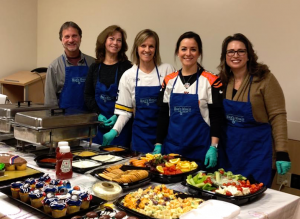
As evidenced by the name, MMM serves monthly meals, free of charge, to all CBDI families, including on major holidays, and hosts special events such as Spa Day and Super Bowl Sunday. Along with providing custom cakes to the children, MMM immediately answers personal requests of families and staff, whether it is a need for comfort items, special food requests, toys, personal care products or clothing, and holiday-specific or support activity supplies. To date, every request has been fulfilled. Remembering how it felt to finally leave the hospital, home at last but away from the watchful eyes of skilled doctors and nurses, Kristi also created take-home bags to give to discharged families to help them confidently care for their children. These “Helping Hands” bags include a flashlight for checking on their child at night, a thermometer, hand sanitizer, and much more.
 Their biggest event of the year, Kick Up Your Heels for Max’s Meals, will take place April 6th. Families from around Cincinnati will gather to dance, eat, play games, and raise money for an organization that has positively touched so many lives. Among them, Max, now sixteen, will laugh and chat with his friends like any other high school boy his age. All proceeds go directly to serve CBDI children and their families with meals, comfort items, and support activities with the hope that other children can overcome their diagnoses and start on the road to recovery. The evening will be filled with love, friendship, and laughter, and thanks to the Meyer family and Max’s Meals & More, it will continue to touch the lives of many even after the music fades.
Their biggest event of the year, Kick Up Your Heels for Max’s Meals, will take place April 6th. Families from around Cincinnati will gather to dance, eat, play games, and raise money for an organization that has positively touched so many lives. Among them, Max, now sixteen, will laugh and chat with his friends like any other high school boy his age. All proceeds go directly to serve CBDI children and their families with meals, comfort items, and support activities with the hope that other children can overcome their diagnoses and start on the road to recovery. The evening will be filled with love, friendship, and laughter, and thanks to the Meyer family and Max’s Meals & More, it will continue to touch the lives of many even after the music fades.
For more information on Max’s Meals, or if you are interested in volunteering or attending the fundraiser, please visit http://www.maxsmeals.org/.
]]>
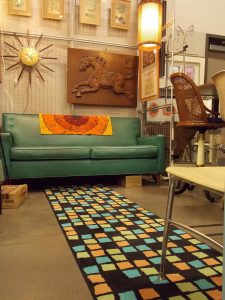 For better or worse, one thing that defines me is my love of antiques and collectibles. For forty years I’ve spent time nearly every week looking for and discovering relics of design and creativity that help me in my understanding and appreciation of our world. I have favorite places and events that I frequent consistently that help to fuel my passion. At the top of the list is the 20th Century Cincinnati show and sale that arrives at the Sharonville convention center on February 24th and 25th this year.
For better or worse, one thing that defines me is my love of antiques and collectibles. For forty years I’ve spent time nearly every week looking for and discovering relics of design and creativity that help me in my understanding and appreciation of our world. I have favorite places and events that I frequent consistently that help to fuel my passion. At the top of the list is the 20th Century Cincinnati show and sale that arrives at the Sharonville convention center on February 24th and 25th this year.
Top five reasons why the 20th Century Cincinnati is the coup de grâce for collectors.
- The show is visually stimulating and has a wide variety of items from the Modernism era including artwork, furniture, accessories, lighting, jewelry, clothing, glassware and pottery.
- There are unique and one-of-a-kind items that I covet and am able add to my collection.
- All the dealers are knowledgeable professionals so the amount of quality merchandise is always overwhelming with much of it reasonably priced.
- This loose knit, offbeat collection of buyers and sellers are the coolest people on the planet. You have to be there to experience the vibe of the room and to listen to the shared excitement about this era to understand the dynamic.
- The show acts as a time machine that takes me back to the era I was born into. The 60’s were a time of rebellion and exploration for our culture. The items produced in that era define the mindset of that time
Details about the show
There are 70 regional and national dealers at the show and they display many 20th century’s signature 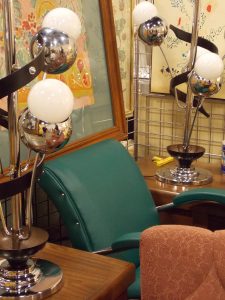 designers and artists. The term mid-century is used as a catch phrase for a variety of styles. It can encompass Art Deco, Contemporary, Machine Age, Modern and Pop Art era objects, which will be well represented at the show.
designers and artists. The term mid-century is used as a catch phrase for a variety of styles. It can encompass Art Deco, Contemporary, Machine Age, Modern and Pop Art era objects, which will be well represented at the show.
Every year the show features an in-depth display of a product or artist from the era. This year’s feature is from the Blenko Glass Company. The company will present the exhibit “American Handcraft in the Modern Age.” The display will include historical artifacts, a display of vintage works, and contemporary creations for sale. Although the company had been creating hand blown glass since 1893, it is the mid-century period examples that have become a staple in the homes of vintage modern collectors.
For the serious collector
 An exclusive two-hour Java Preview will kickoff 20th Century Cincinnati activities at 9 a.m. Saturday. Advance tickets are $25 and may be acquired online, by phone, or mail. Preview tickets will also be available at the door Saturday morning for $30. The tickets include early shopping 9 -11 a.m., complimentary coffee/juice bar, and a full-weekend pass.
An exclusive two-hour Java Preview will kickoff 20th Century Cincinnati activities at 9 a.m. Saturday. Advance tickets are $25 and may be acquired online, by phone, or mail. Preview tickets will also be available at the door Saturday morning for $30. The tickets include early shopping 9 -11 a.m., complimentary coffee/juice bar, and a full-weekend pass.
Show hours are 11 a.m. to 5 p.m. both days. Adult admission is $8. Passes are good for both days. The Sharonville Convention Center is located at 11355 Chester Road just off I-75 at the Sharon Road exit (exit #15).
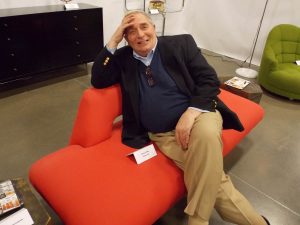
Finally, for more information, visit
www.20thcenturycincinnati.com or call 513-738-7256
]]>
Every year around this time I am reminded that one of my favorite places to be happy is the 20th Century Cincinnati Show. It has become the largest Modernism show in the Midwest with more than 70 dealers from a dozen states. The show covers every inch of the 20,000 square feet in the Sharonville Convention Center. This year’s show is on February 25 and 26.
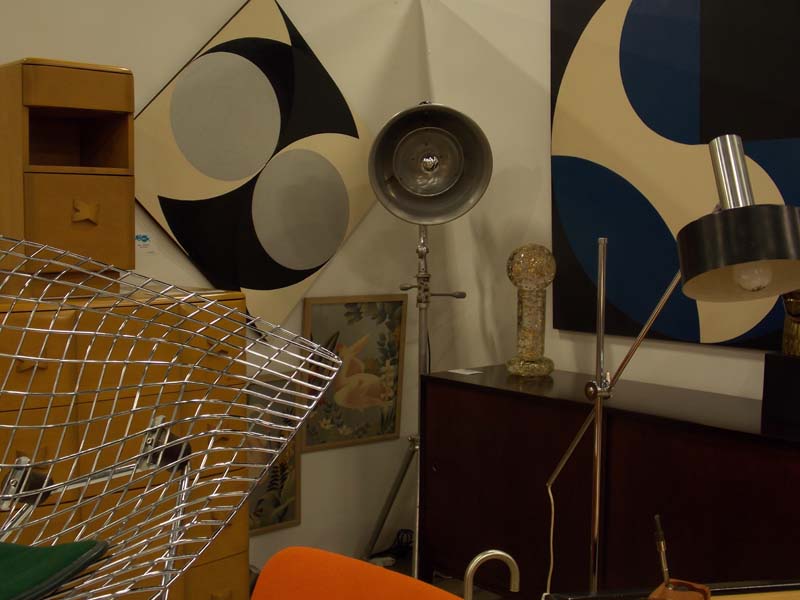
I’ve attended hundreds of antique and collectible shows across the country. Some shows have a personality and a presence about them. The best shows feel like living entities because they are packed with artful creations from some of the most creative minds on the planet. This 20th Century show stands out because of the quality and volume of merchandise. The vast array of products is complemented by the knowledge of the elite group of dealers at the show who know their wares. Here is a list of the participating dealers: http://20thcenturycincinnati.com/dealers/
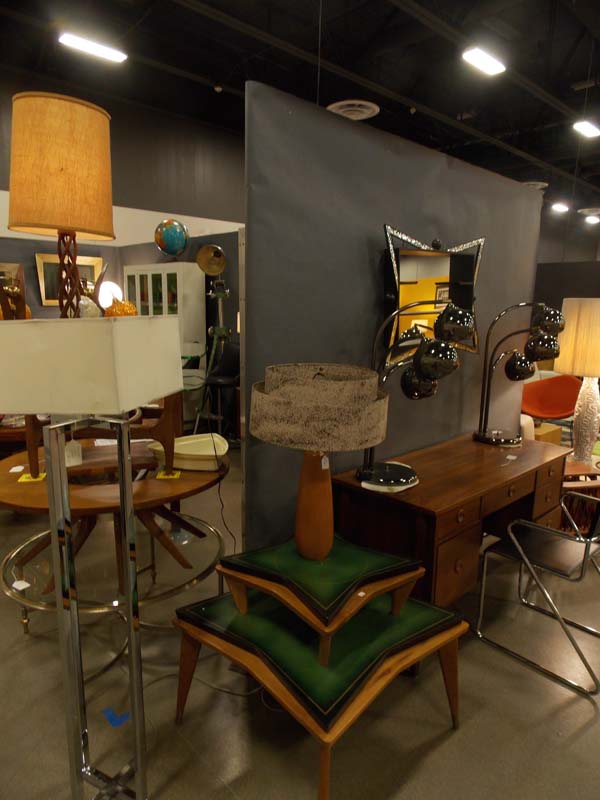
A rebellion of culture and design
The 50s and 60s were a renaissance period for architecture and design. The turmoil and uncertainty of the time forged a culture of individuals who challenged traditional thinking. The art and design community of the time questioned how we lived and the products we possessed and then inspired one another to depart from tradition and take a radical turn. The inventiveness of that time still inspires and may be more appreciated today than in the time it was birthed.
By the early 60s, modern art covered the walls in most homes. There was a new manufacturing approach in furniture and accessories of the period too, with straight-line designs and new age materials brought on by space age technology. Music and literature took a radical turn as well with looser structure and free form expression. Soft and gentle became loud and hard. A new era of style and design was born and it still thrives today among enthusiasts who embrace the passion and inventiveness of a time that is now described as the Modernism era.
The 20th Century Cincinnati show features a wide range of Modern products which also broadly encompasses the Arts and Crafts, Mid-Century, Art Deco and Post Modern periods among others.
Experienced and novice collectors who attend find products that meet their fancy from the ultimately rare and unusual, to the affordable, mass produced items from their childhood. Show attendees are consistently impressed by the broad selection of vintage furniture, lighting, artwork and pottery according to show director Bruce Metzger.
“This show specializes in furniture and accessories that are ready to go from the floor of the convention center directly into your home,” Metzger says.
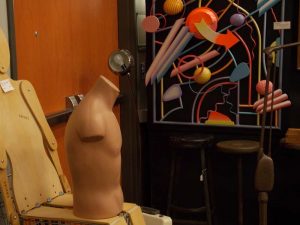
While the dealers at the show remain consistent from year to year, Metzger was pleased to announce that one of the areas largest dealers in Mid Century products, Flower Child, (with stores in Columbus and Cleveland) will be displaying for the first time at this year’s show.
Another stand out category of merchandise will be a large representation of vintage clothing and jewelry from Kimberly Klosterman, The Gilded Lily, Somewhere in Time, Bel-Air Jewelry and other dealers who specialize in fashion and accessories from the era.
Every year the show offers a special exhibit that takes a deeper look at products and design from the Modernism era. This year’s exhibit features some architectural details of six iconic “drafted and crafted” Mid Century Modern homes in Cincinnati.

Cincinnati’s non-profit modern design forum cf3 is presenting the exhibit which will feature representations of hand-drawn blueprints, plans and drawings of the homes. The digitized original drawings invite the viewer to consider similarities in the design process irrespective of an architect’s means of documentation and expression. The drawings will be supplemented by both period and contemporary photographs, as well as other related ephemera.
Weekend activities begin with a two-hour Java Preview beginning at 9:00 a.m. Saturday. Preview tickets admit patrons to the exclusive shopping period (complete with a complimentary coffee, tea and juice bar) and include a full-weekend pass. Preview ticket ordering information is on the website: http://20thcenturycincinnati.com/java-preview/
Regular show hours on Saturday and Sunday are from 11:00 a.m. to 5:00 p.m. The $8 adult admission is good for both days.
The Sharonville Convention Center is located at 11355 Chester Road just off I-75 at the Sharon Road exit (exit #15). Parking is free and all areas of the facility are wheelchair accessible.
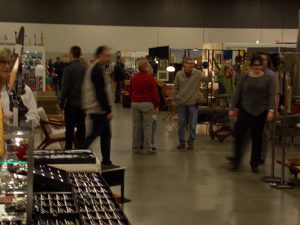
The Positive 365 book of quotes helped me understand fully how we are all tethered together by a force greater than ourselves. Strangers told me stories about how the book made a difference in their lives or changed a relationship or uplifted someone they loved who needed to hear an encouraging word. I realized these people who read the book were no longer strangers. In fact I realized that there really aren’t any strangers. There are only people I don’t know well enough. Abe Lincoln’s quote, “I don’t like that fellow, I must get to know him better” resonates with me because of the positive personal reactions from people I didn’t know as they commented about the book.
I’m very excited to announce there is a new and improved version of the Positive 365. It’s called the Positive 366 – The Leap Year edition. This new book of 366 quotes is the result of a chance meeting with a friend of mine’s autistic son. As I handed him the book when it was published in 2012, he immediately told me the book was wrong. He read the cover and said, “There isn’t a quote for everyday because there are 366 days this year.” (2012 was a leap year.) We had a laugh about his perspective, but the thought stuck with me.
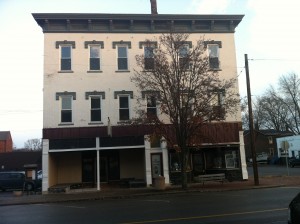
As I collected and organized these quotes for publication I was struck by what a difference they made in my thinking every time I read them. I laughed out loud at some and felt heart felt conviction in others. There is great collected wisdom in these condensed blurbs of reflective thought by some of humanity’s greatest minds.
I decided to whittle down the list to my absolute favorite quotes. The condensing of the quotes that resonated with me at my core taught me something about my mind and my attitude. I’ll let you jump to your own conclusions on what I learned from compiling this new group of quotes. Here are the quotes at the top of my list:
7) “If it can be solved, there is no need to worry, and if it can’t be solved, worry is of no use.” Dalai Lama
6) “Plenty of people miss their share of happiness, not because they never found it, but because they didn’t stop to enjoy it.” William Feather
5) “The cave you fear to enter holds the treasure that you seek.” Joseph Campbell
4) “We are not human beings having a spiritual experience, but spiritual beings having a human experience.” Teilhard de Chardin
3) “The melody of our authentic self is within all of us… if we will be still enough to hear our song and brave enough to dance our dance.” Sam Wilder
2) “I’ve become convinced that the things that matter most are the things that you can’t see — the love you share with others, your inner purpose, your comfort with who you are.” Jimmy Carter
1) “When we want to make another person happy we want to give them something. But the most precious thing you can give him or her is not something you buy from the market. It is your true presence.” Thich Nhat Hanh
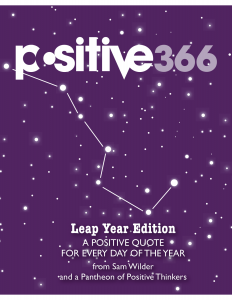
The all-new Positive 366 Leap year Book of Quotes is available on Amazon. These positive quotes delivered a positive thought to me in a meaningful way. My hope it is that reading this book is something you can’t not do! I know it’s a leap you won’t regret-
Here’s the link to the book on Amazon:
http://www.amazon.com/Positive-366-Sam-Wilder/dp/0692618872/ref=sr_1_1?ie=UTF8&qid=1459973503&sr=8-1&keywords=positive+366
]]>

Hostetler was an attractive old soul, a bearded, feisty, bandanna-wearing, eighty-two-year-old Renaissance man who laughs easily at himself. His rugged hands show the wear from thousands of gouges in wood over fifty years working as a sculptor. He was a modern-day Don Quixote—but instead of seeing a windmill as a dragon, he looked at a tree and saw the female form that lied within. He was one of America’s greatest living sculptors before his passing in late 2015.
The scope of his work includes 600 sculptures that stand in museums, private collections and galleries around the world, in front of the Trump Tower in New York and the Kennedy Library in Boston. His riveting story, born from a tumultuous generation that created a man with ardor in his work. Hostetler embodied a well-lived journey.
A woman lovely as a tree
It seems odd at first that women are the subject matter of every one of his sculptures. But as you listened to Hostetler, you became entangled in his fascination with the female form. “Women remain child-like with their voices and that softness… Women are the warmth, they are the ideal form, exotic yet pure, compositionally variable, yet identical every time. Life itself comes from woman.” Hostetler praised. “The rooster can strut around the barnyard, but it’s the hen that lays the egg.” He didn’t apologize for his obsession. “It has led me from the contemporary woman as mother, wife, nurturer, to vamp, seductress and queen,” Hostetler said.
He spent a lifetime studying women’s role in society. “This art form for me is constant discovery. This idea of women . . . I’m (always) searching to find answers. Now I’m back 4,000 years in the history of women. My focus is Near East with Minoan, Cretin and Cycladic imagery. I’m still looking,” said Hostetler. “It’s like Giacometti said, I’ll leave without the answer and that’s the way it should be, because it’s part of the evolutionary process.” But as you listened to him you would wonder if he actually did have his answer.
Small town momma’s boy
His humble beginnings were in the town of Beach City, Ohio, which offered neither a beach nor a city. He remembered his father as a brooding unhappy man who was raised Amish but left the sect because he considered the Amish “cowards” because they wouldn’t fight in World War I. His mother was nurturing, warm and protective. Hostetler was a self proclaimed momma’s boy, enamored with women early on.
He joined the Army at seventeen during World War II and tested so high on entrance exams that he was placed in a special unit to become an army engineer. His time studying for the army at Ohio University led him to what would become the loves of his life, woman and art. Hostetler’s military career was cut short by a training exercise that left shrapnel in his leg. His Army hospital bunkmate was a watercolor artist and with the offer of free art supplies from the Red Cross, Hostetler began drawing and discovered what would become his lifelong passion.
During his yearlong recovery in 1946 he was earning $20 each week from the military (known affectionately by veterans as the 52-20 club). He studied art history and learned how to live an artist’s lifestyle. “You could drink a lot of beer for $20 a week back then,” Hostetler chuckled. He audited classes at Cleveland University and was tutored casually by Albert Hise, an art historian and director of the Massillon (Ohio) Museum. “I fell in love with art history and Shakespeare that summer” said Hostetler.
His first immersion into the application of art was at Indiana University in Bloomington, Ind., where he met his mentor in Professor Karl Martz. In the first class, Martz masterfully turned three lumps of clay into beautiful vessels of varying shapes within minutes. Hostetler exclaimed, “You could make hundreds of them a day.” To which Martz softly replied “But who would want to?” With that statement Hostetler began to understand the nature of the true artist. Karl Martz’ soft and gentle demeanor had a lasting impact on the person that Hostetler has become. Hostetler also learned a great deal from the respected colony of artists near the university, known as the Brown County School.
Hostetler made a living in pottery in the late forties and early fifties with a large pottery operation in Athens, Ohio and a sales office at the Merchandise Mart in Chicago. He believes his days as a potter were great training for his future as a sculpture because “pottery is about contour and potters also see silhouettes in shapes.”
Rekindling a vision
His fond memories of a quaint campus filled with beautiful women while studying to be an Army Engineer were like a siren call to Hostetler. He returned to Athens to obtain a masters degree in fine arts at Ohio University. He taught art there for more than thirty-five years and was known as a patient man who taught students to celebrate life with their art. His students include David True, Harvey Breverman and Jim Dine. Dine collaborated with Hostetler in his shop in Athens and in studios in New York City. Hostetler spent over a decade with Dine in New York City but left because he felt he was loosing touch with himself as an artist and as a person. Hostetler said, “I started not to know who the hell I was. It was a slippery slope. My agent at the time said, if you cross the Hudson River your history… and she was right. They don’t give out the prizes here in the woods (in Athens), but this is what I need,” Hostetler reflected. One of his students, Estrellita Karsh, describes Hostetler as “a divine human… funny, witty and a very good friend. David is the kind of man phonies copy.”
Hostetler felt “Most (artists) take a more time sensitive approach to producing their art in ways that doesn’t take months. “Time in America seems to be critical in our lifestyle at the moment. It isn’t for me. There is no wrist watch. Time on my wrist, I gave up years ago.” He is one of a handful of wood sculptors that still uses the old school approach of carving by hand with gouges. “The removal of the wood is a very mantra-esque act. I get into a rhythm just like playing the drums,” Hostetler said as he counted 4/4 time while taping away on his latest form. He was an avid jazz drummer but claims he doesn’t have the innate talent to achieve the desired sound on the drums. He was bewildered by his shortcomings as a musician juxtaposed to the ease in which he has created his sculptures and paintings. “I feel my limits in music but I don’t feel them in art,” Hostetler said.
The wondering Hostetler finds himself at home
“They say the teenage years are the toughest, but for me it was midlife. I tried to travel to find myself in the seventies but all I found was that wherever I traveled, I was still me, and my monkeys were still with me,” Hostetler states. He called that period of time his “butterfly years.” “I had fifteen years where I discarded my persona, hopped on a motorcycle and I was questing. I was moving from place to place and woman to woman. What I really discovered was that everything I wanted was here (at his studio). I am happiest here in my sandbox because I built it that way. I built my own Disney World,” Hostetler said. “Art is a mirror image of a person’s life discovery. My biggest discovery (then) was to activate my women,” Hostetler said. Hostetler accomplished some of his most popular work in this era including the Walking Woman and Dancing Lady series. These sculptures were different than his previous work because his “women” showed motion.
Hostetler gave freely to his life to his art, sacrificing relationships in that process. One of his girlfriends burst into his studio in the early 80’s and shouted, “You like your art better than me.” Hostetler could do nothing but agree with her. Hostetler has had many relationships with a wide variety of woman, many of whom who are immortalized in his work. He feels that it is difficult to “find your flower” and stay with the same person for 50 or 60 years. Hostetler believed “People don’t evolve or they evolve in different ways.” In 1983 Hostetler found his flower in Susan Crehan. The only prenuptial he demanded was that his art would always come first. She agreed and they married in 1986. He credited her with establishing the true value of his art to collectors. For the first time in his life, Hostetler heard bells. “I was vapors when I met her,” Hostetler confessed. After more than 20 years together their relationship inspired one of Hostetler’s greatest works in the 13-foot sculpture he named The Duo.
Nature’s culling
Hostetler believed that evolution has hardwired humans for destruction because we are a patriarchal society. “Religion is patriarchal not matriarchal,” according to Hostetler. He felt our society would be better served by being matriarchal. “I studied Judaism for almost ten years. When it came time to make that leap of faith to believe in that little man in the sky, I couldn’t do it… maybe if it was a little woman in the sky I could,” Hostetler professed. When pressed, he describes himself as a pantheist. His love of nature is undeniable.
Hostetler’s most prized possession was a gigantic pre-civil war oak tree on his farm. “I am enamored with wood. It’s a living material. Its own existence is recorded in its calendar of rings. Whenever I need a little more spiritual attitude, I go back and look at our roots which are after all – nature – from whence we came. Art is, for the most part, spiritual. ” Hostetler said. “(For) a worthwhile artist, their work is an autobiographical sketch of their life. It’s like the psychologist that is trying to discover who they are.” Hostetler hypothesizes. “Maybe (my art) is a search for the strength of women in all of us?” Hostetler added after a lengthy pause.
David Hostetler inspired because he was a man who went searching for who he was and found himself in his art. “I’ve been so blessed, but everybody is in a way.” He confided, “If you follow your bliss – It’s very hard to lose. Because you’ve got your passion and nobody can take it that from you – and that’s the gift.”
]]>
Yet other days, the sky filled with rich blue, sunshine and rainbows. We retained a shrouded, foggy recollection of our Irish experiences. Who can say whether our memories were clouded by weather, whiskey or the magic of that island? From these misty moments, we collected our cle
arest thoughts, bits that we could hold at a distance of a few months time. Ireland gave us these rich memories, with dialogue in soft brogue, rolling hills and old stone, woolen socks and beautiful landscapes.
Chasing rainbows in the West of Ireland
It seemed too magical: To arrive sleep-deprived, plane-stale, and suddenly be driving down winding roads with rainbows at every curve. But they lingered for hours. It would rain occasionally, and the skies would clear enough to let some sun shine through. Again, another rainbow.
The morning we arrived in Ireland, we set off for the multi-hour drive from the Shannon airport to our destination: Clifden, a small town on the western coast. Every few minutes, it seemed, we’d turn around a bend in the road or crest a hill to find a rainbow.
I snapped photos from inside the car, most of them polluted by road signs and poor camera angles. We spotted a double rainbow that we couldn’t quite catch in a digital image. I couldn’t help but think of these natural light phenomena as a friendly greeting as we arrived for a vacation in Ireland.
It was a tease, or perhaps some Irish humor at the start of the trip. I didn’t see one again for the remainder of the week.
—Suzanne Clark

The language of tradition
I went to Ireland with my Irish Catholic mother, having promised her that we would make the trip together. It was her first time outside the United States, which meant I was our chauffeur and tour guide. This included navigating rotary intersections (roundabouts) and winding cliff-side roads as my mom tried to avert panic from the passenger seat. It also meant I regularly responded to questions such as, “Do you think they take American dollars here?” and “Well, why don’t they do it our way? Our way is better.”
But there was one place where her understanding of Ireland and Irish people was deeper than anything I, as our guide, knew: the church. Raised by Irish parents and in Catholic schools, my mom knew exactly what to do when she walked into that first Irish church at the end of our street in Clifden. She went directly to the prayer candles and lit one “for Grandpa,” meaning her father and my grandfather, who had always wanted to visit Ireland. She knew to make the mandatory donation and to kneel before the Virgin Mary in prayer. She even knew the appropriate prayer to say, in Latin.
In this land, where religion played a major part in everyday life as well as politics, war and history, she found a piece of her own past. For as far away from home as my mom must have felt on that first journey abroad, she could speak the language of the church, uniting herself with her ancestry and traditions hundreds of years old.
—Katie Scarlett Brandt

“Will you take our picture on the sheep?” A girl in a bright pink jacket ran across the lawn to ask me. Another girl, maybe 2 years old and whom I assume was the little sister, struggled to keep up. We were in the garden of a castle called Kylemore Abbey, which an English tycoon had built in the 1860s as a token of love for his wife and later changed hands to a group of Benedictine nuns. “Please?” the girl said.
I agreed, and the girls raced onto a pair of sheep statues. After I snapped the photo, the older one asked to see it, exclaiming, “Look at Fern! Isn’t she so cute?” She was. And so were the sheep.
This was not the first
time I had snapped photos of sheep, though my previous shots had been of the live variety. Outside Galway on the drive in, I was distracted by the mass of fluffy white coats stretching across the green landscape. I almost missed the one directly in front of my car and only narrowly avoided running her over. The sheep seemed so coolly unimpressed by everything; they’re not visibly afraid of cars or people. They meandered along the lakes, down the roadside, and in the middle of the road. They were everywhere—some spray painted with streaks of blue, red, or yellow to denote ownership.
I couldn’t get enough of this creature so entrenched in Irish culture. There are actually far more sheep (8 million) than people (4.7 million) in the country. And because I couldn’t actually (legally) bring one home with me, I now own enough pairs of wool socks that I could wear a new pair everyday. For a week.
—KSB
The view from the top of Connemara
From the highest point of Connemara National Park, the wind was brutal. I had layered on a sweater, two jackets and a hat, and still felt battered. But after a one-and-a-half-hour hike upwards. I looked down at my sneakers, and the stones under my feet, then out across the sweep of landscape below me. I conquered this Irish hill. I felt triumphant.
One of only six national parks in Ireland, Connemara has a simple trail system that takes hikers up to a massive hill, rockier at the top but with stunning views. As you climb, you see more and more of the surrounding countryside, the edge of land and the beginning of the Irish Sea.
For a few minutes, my companions and I rested at the top before beginning our journey downward. One of us, a devotee of yoga, stretched into a side-plank on a pile of stones. But we could see the clouds rolling ever closer as we began our journey downward. We were rain-soaked when we reached the park building at the bottom, and the car smelled of wet wool on our drive back to Clifden.
—SC

Riding bikes on the Aran Islands
The brakes on my bicycle were squishy, while the seat was hard. But the gently rolling roads ofInishmore, the largest of the Aran Islands, were perfect for refreshing my cycling skills. A 45-minute ferry ride across Galway Bay delivered us to the island, and I convinced my husband that biking, rather than carriage ride or tour bus, was the best way to see the island.
The beach road, which curved along the edge of the island, provided views of crashing waves, rough shores and livestock scattered among tiny plots of land divided by old stonewalls. Goats climbed freely, munching weeds sprouting between stones; cows, horses and sheep passively remained within their boundaries. These sights would have been a blur in a tour bus, but we could stop at leisure to laugh at the goats or snack on apples. Letting myself glide down a hill, I couldn’t deny the giddy feeling I had, with the salt-tinged breeze blowing, the views of old cottages and rugged landscapes softening with my speed.
After a few miles of pedaling, we parked our vehicles in a sea of other rental bicycles at the base of a hill and climbed on foot to the top of Dun Aengus, the remains of a prehistoric fortress perched on a cliff. I sat on the edge of an old rock foundation, legs dangling into nothingness, and watched the waves crashing below me. For a moment, I thought about what it might feel like to be one of those waves, slamming into the rock face that stretched from my legs to the water. Then I stood back up, descended the hill and climbed on top the hard bicycle seat for the return trip to the ferry.
—SC
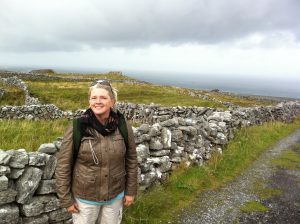
Irish Stonewalls and souvenirs
Having purchased enough wool socks to risk being charged as an importer by U.S. customs, I decided to bring back a different sort of souvenir: a rock from one of Ireland’s stonewalls. The walls serve as a backdrop throughout Ireland and as home to the animals and plants that settle in them—small birds, mammals and mosses. No matter how round or jagged, each stone contributes to the overall personality of its wall, bringing the entire structure to life.
Ireland boasts a quarter-million miles of these dry, handmade walls, most built after the Great Famine of the 1840s. On the island of Inishmore alone (winter population 900), 10,000 miles of walls divide the rocky terrain into square plots. Within those plots, people in centuries past created their own dirt for crops by using seaweed as a base. I spent my time on the island searching for just the right stone to carry home with me. I hunted in cemeteries, on roadsides and beaches. Finally, I found the perfect one, six inches across, on a wall surrounding a home in Inishmore’s main town, Kilronan. My mom photographed me using it to write a message in the sand to my boyfriend back home, and now it sits on our bookshelf, a piece of Ireland as unassuming and uniquely Irish as the wall from which it came.
—KSB

After an hour’s drive down a one-lane road that snaked around mountains and loughs, black bricks began dotting the rolling landscape: Peat, drying under overcast skies. Their mere presence felt eerie. Connemara is desolate enough that while driving its country roads, you see few houses and fewer people. The region’s isolation leads you to believe in the chance that no one has been in this exact spot before. These piles of peat prove that someone has. Someone dug this peat out of the bogland. And they will return to collect it.
Peat bogs makes up three percent of the earth’s land area, and under the right conditions, eventually turns to coal. In Ireland, which holds about 10 percent of Europe’s peatland, it’s used for fuel and to distill whisky. Walking down Clifden’s streets at dusk, I smelled the smoky-earth scent of peat burning every night. It signaled people settling in for the evening, chasing the chill from their homes with fires made from the hardened briquettes.
Now, as I pulled the car over and walked toward the drying peat, my feet sank into the ground with each step. For the first time in my life, I risked being literally “bogged down” in the damp earth below me. The peat was heavy, wet, and left dirt and grass between my fingers. As I turned a brick over in my hand, I wondered if one of the farmers would appear to chide me. Yet for as far as I could see in any direction, the only other living creatures in this remote landscape framed by mountains were the sheep.
—KSB

All my days in Ireland ended in a pub, a habit apparently true for more than just tourists. We would gather around a small wooden table or as close to a hearth as possible, chat with locals, and break down our days. Where we had gone and what we had seen changed daily, but one constant remained: glasses of whiskey on the table. Always three or four of them, always with a single ice cube at their centers, and always a promise of a smooth end to an intrepid day.
After a week of drinking whiskey, splitting my time between Jameson and Powers in countryside pubs, I took a trip to the Jameson Distillery in Dublin. Businessman John Jameson founded the distillery in 1780, under the motto “sine metu,” which means “without fear” and appears on every bottle. Today, the company sells more than 30 million bottles a year.
I was chosen with a handful of other people from my tour group to serve as “official whiskey taster.” It’s difficult to explain the sense of pride that overtook me, but as I sat down to my blind taste test, setting Jameson against Scotland’s Johnnie Walker and America’s Jack Daniels, my experiences of the past week flooded my thoughts. I took my time finishing the tiny shot glasses, casting my vote unknowingly for Jameson, and soaking in the sights of the distillery.
I wasn’t certain I’d ever be back again, or that whiskey would ever taste as it did in those pubs with their low ceilings and tiny tables. Even as I write this, I want to pour myself a glass, sit back, and imagine I’m back at the distillery—or at any one of the pubs in which I spent my nights in Ireland—warmed from the misty cold by drink, fire and fiddle.
—KSB

On our last full day in Clifden, I perched atop a bar stool, sipping an Irish coffee, and one of my companions carried over a Guinness. A shamrock etched in the foam atop the dark brew showed the work of a bartender with a quick hand. We admired the alcohol-based artwork and watched as rain dripped outside the windows of the Alcock and Brown Hotel. The afternoon’s entertainment was about to begin, and this felt like the quintessential way to celebrate being a writer in Ireland.
For the next hour, I sat rapt as poets read their work. Even the names of the poets there had a poetic English-Irish ring: James Harpur and Gerard Smyth, Mary O’Malley and Eugene O’Connell. The event was a hundredth birthday memorial for poet Czeslaw Milosz, as well as the launch of theCork Literary Review. It was one of the final acts of the Clifden Arts Week, an annual celebration of painting, music, literature and other creative arts. Toward the end of the session, a man played a short interlude on fiddle, another treat before leaving the warmth of the bar to walk to our temporary home.
Afterward, I looked up poems by Czeslaw Milosz, and these words lingered with me, from his poem “Ars Poetica.”
The purpose of poetry is to remind us
how difficult it is to remain just one person,
for our house is open, there are no keys in the doors,
and invisible guests come in and out at will.
What I’m saying here is not, I agree, poetry,
as poems should be written rarely and reluctantly,
under unbearable duress and only with the hope
that good spirits, not evil ones, choose us for their instrument.
—SC
]]>Janet Rowley died in December, and I still wake up some mornings hoping I can still call her and invite myself to breakfast, anticipating a hug at the door and a bowl of homemade granola on the table. This is how it had been for the past seven years as I wrote her biography.
We would shuffle to the back of her house, to the solarium, which felt like a greenhouse even in the depths of winter. After catching up on where I was with the manuscript, I would ask about recent news—government spying, wars in Africa, new cancer research. I wanted Janet’s take on this complicated world, as she was a wildly intelligent, creative woman who could offer perspective. In more recent months, the conversation would wind back to her husband, the innovative pathologist and immunologist Donald Rowley, who passed away in February 2013.
With regard to some obstacle tackled in the kitchen or another mystery solved in the lab, she would say, “That’s just how he was—brilliant.” Janet always took the seat at the table right below his photos—two computer printouts taped to the wall. “Cheers,” we would say.
Janet was brilliant, too. Her CV stretches to nearly 60 pages and holds so many awards and honorary degrees that even after seven years as her biographer I can’t recall all of them. When Donald first brought her from Chicago to Minnesota to meet his parents in 1947, he told his father that Janet had one of the best minds he had ever encountered.
One day before their 65th wedding anniversary and 65 years to the day after graduating medical school, Janet passed away. She left behind hundreds of family members and friends, millions of people affected by her work, and a laboratory still fighting to answer questions she initiated 40 years ago.
I knew Janet through most of my 20s, and my work as a biographer positioned me to ask extremely intimate questions and witness what life meant to her. Here are five lessons I learned, which will stay with me for the rest of my life:
1). Don’t let age define what you accomplish.
Janet was undaunted by certain societal expectations. She relied on her intuition and personal experiences to make decisions, rather than pressure from outside influences. When Janet applied to medical school in 1943, the school had already filled its quota of three women per class. She waited nine months until the next available opening. Thirty years later, Janet made her first major discovery. Too often, she has lamented, people tend to fault themselves if they haven’t accomplished anything major by age 30. While other researchers let their self-perceived failures define them, Janet searched for patterns in chromosomes, leading to a discovery that translated into life-saving cancer treatment. Then, she kept at it. Janet was 50 before the broader scientific community accepted her work, 73 when she won the National Medal of Science, and 87 when she received the Japan Prize.
2). Be an informed participant in the world.
Janet was rallying against sequestration’s potentially “catastrophic effects” long before I began hearing the buzzword. That diligence came through in her professional life, too. On George W. Bush’s Bioethics Council in the early 2000s, Janet reviewed reports on everything from stem cell research to health insurance. But she would turn in her edits days after deadline. The first time it happened, Council Chairman Leon Kass said he was furious. However, he added, “She did her homework. She read everything line-by-line, page-by-page. The reports were made clearly better by her care.” So listen to NPR. Read The New York Times over breakfast. Keep the latest periodicals, from Nature to The New Yorker, close at hand. And do your homework.
3). Give the people closest to you enough space to make their own decisions.
This includes you. Janet said she always valued time in her garden, where she had many epiphanies. With space away from work, she could let her thoughts wander. Giving loved ones space may be more difficult, because it means letting go of control. At 19, Janet’s son Donnie moved across the country to Oregon, where he lived in a tree house, removed from society. She worried until she realized the worry might kill her. And what good was that? Janet knew she couldn’t do anything except be available when he needed her. She understood fiercely independent spirits, being one herself, and also seemed to believe that she couldn’t make someone do something they weren’t ready to do.
4). Have a glass of wine with dinner, but then get back to work.
You have to find something in life that you feel passionately about—enough to do it even after a long work day, even when you could zone out on the couch instead. Your passion itself might take immense effort, but doing it will energize you. Especially for people just starting out, Janet said, “You’re going to need patience.”
5). If you find a partner in life, support that person. (But support yourself, too.)
Janet did this for Donald, whether that meant taking care of their sons while he returned to the lab after dinner, or standing by him later in life when he mass-produced a table he had designed, or opening up when he commissioned me to write her biography. However, Donald brought Janet to tears while editing one of her papers after she discovered the second translocation in leukemia: She claimed the translocations were driving cancer; he wanted to know what was causing the translocations. But Janet believed in her theory. She pushed herself—first in the face of Donald’s challenge, and then in front of scientists worldwide. The way we think about and treat cancer today would be much different if she hadn’t.
]]>Why she gave this to me and not her other five children remains unclear. Perhaps she saw my disillusionment with the rat-a-tat, airless echo of school, the Catholic Church, the Sunday roast dinners and our predictable life. I had been punished a number of times for staring out the school window day-dreaming about who knows what, maybe stink bugs. Then came the thwack of the ruler, held by a tight-fisted, chalky nun who sent me off to kneel on the concrete hallway floor for two hours. I would later go home and draw pictures of nuns being kidnapped, held in dark closets, being starved, begging for mercy. I hid the stories under my bed, accompanying the other stacks, all concerning some level of inequality.
During this time, music and freedom called my mother to another place, a more hopeful existence where she wouldn’t be a “wife.” She was a hippy to my father’s buttoned-up businessman. My mother did not have many heroes, as they were fleeting and then dead: Malcolm X, Martin Luther King Jr. and the Kennedys. But there was something about Einstein that settled into her very core, then mine.
A new life began and I took Albert along as a companion
In 1969, she had had enough. She confided in me: “We are leaving. Tell no one; your sisters won’t understand. Your father will return to an empty house, to complement his empty existence.”
Then: “Imagination is more important than knowledge. Don’t forget that. Ever.”
Thus began my own obsession with Einstein. I tucked these quotes into my grandmother’s jewelry box, which she had given me just prior to her death.
Legions of people remain enamored by this brilliant man, not just for what he discovered, accomplished and how he radically changed the world, but because of his childlike innocence, his unlimited curiosity, great humility, a legacy of words that continue to endure. When you ask a complete stranger who defines genius, they might reply, “Oh, Einstein.”
And he was a rascal, with wild eyes, the mop of hair, his crumpled clothes. This made him real for the rest of us. I began to collect quotes and read about him in libraries. His humor brought me great comfort. He wasn’t some impervious man one couldn’t access. He didn’t believe in separating himself from others, and in fact loved sharing his ideas, while helping others expand on their own. He was approachable, both alive and dead.
Born with a kind of eternal intelligence, his curiosity about all things began to emerge at age four. While examining his father’s pocket compass, Einstein was baffled. What was causing the needle to move? The empty space made no sense to him. He began to build models and mechanical devices for fun. He wanted answers. Age 10, he met Max Talmey, a poor, Jewish medical student from Poland, who introduced him to science, math, philosophy, Immanuel Kant’s Critique of Pure Reason and Euclid’s Elements, which Einstein dubbed “the holy little geometry book.”
He was brilliant in his own way
As a boy, his father knew little Albert was gifted, and perhaps because the elder Einstein (an engineer) had failed at so many businesses, he insisted his son stay in school. He enrolled him in a school in Munich to pursue engineering, but Albert was frustrated with the educational system. He clashed repeatedly with the authorities, resented their teaching style and wrote about how schools were essentially killing the creative spirit and curiosity of its students. He was 15.
“The only thing that interferes with my learning is my education.” When I read this in junior high school, I could finally relax. The simple statement brought along a universe of vindication because I simply could not understand the entire educational process of rote learning. It was too boxed in, too impersonal. I realized I would have to find my own way intellectually alongside the traditional, through books and lectures by Rollo May, Erich Fromm, B.F. Skinner, Timothy Leary and Marshall McLuhan.
I was no genius, simply curious and bored with school. Given the number of times my gypsy mother moved us, staying on track in class made me weary. Another school, another teacher, another set of young people I would have to navigate somehow.
Why has Einstein resonated so deeply with me and so many others? Among the world’s most brilliant minds, he continues to inspire. What of da Vinci, Tesla, Newton, Hawking, Aristotle, Edison, Cervantes? The list goes on. They too share not just powerful minds, but an endless pursuit through curiosity and instinct. They knew knowledge was important, had to be learned, but could only get them so far. The rest is mystery.
Einstein embodies the mystery. So many of his ideas, beyond his incredible discoveries in the world itself, which ultimately turned the world on its head, contain room, empty space, air to breathe. His equation, E = mc2, may be the most famous equation in physics, eventually setting the stage for the development of the atomic bomb and nuclear power plants. But had he known where this was going, he said, he should have become a watchmaker.
To this day, his theories inspire advances in science, astronomy and physics, as well as from philosophers. I keep a tip sheet of quotes tacked up near my computer and read one every day. It really doesn’t matter which one, as they all carry great meaning. With each read I come away with yet another interpretation.
Einstein would go on to fail countless exams when applying to higher learning institutions. Yet, he continued exploring, reading and taking great interest in other’s concepts and ideas. He did eventually get accepted into the Polytechnic in Zurich. He wanted more knowledge and continued developing his own theories and expanding others.
His instincts propelled him yet further
He never lost his ability to stay curious, intuitive and of course, humorous. Despite his apparent genius, upon graduation he could not get a job and landed at the patent office, only to be overlooked for a promotion because he had not managed to grasp machine technology. But it was there that the 26-year-old developed further radical notions in his spare time by analyzing various patents. And he never stopped writing about his findings.
Finally, with some recognition, he left the patent office, and by 1908 was considered as one of the world’s leading scientists. He went on to become a professor in Prague and Berlin, and ultimately became famous a few years later when his theory of relativity at last made a permanent impression on the world. Ten years later, he was awarded the Nobel Prize in Physics.
For many years after, he traveled the globe, lecturing. “Of all the people I have met, I like the Japanese the most, as they are modest, intelligent, considerate, and have a feel for art,” he wrote to one of his sons. This is the statement that captures the man himself. He maintained his own humility until the day he died. He was a genius, but also a gentleman, a humorist, altruist, artist and a great believer in love. “How on earth are you ever going to explain in terms of chemistry and physics so important a biological phenomenon as first love?”
The entire universe was Einstein’s canvas, and he made this world relatable to all of us. I’ve been to my fair share of enlightenment lectures, often given by physicists turned “gurus,” and there they sit, spouting what I had already learned by Einstein’s words:
“Anyone who has never made a mistake has never tried anything new.”
“Great spirits have often encountered violent opposition from weak minds.”
“We can’t solve problems by using the same kind of thinking we used when we created them.”
And of course, perhaps the most famous, his definition of insanity: “Doing the same thing over and over again and expecting different results.”
Meanwhile, back in New Jersey
Of all the great brains, his would be the one cut into 240 pieces, kept in jars, cardboard boxes, often hidden, studied under microscopes. Bits of his grey matter still remain at Princeton University. All those years of cutting, probing and analyzing amounted to little new knowledge of the human mind.
The contradiction rattles the very jars into a pulpy mess, if only because it contradicts what Einstein tried to impress. Stay curious and questioning; love the mystery. Conventional knowledge, though essential, is finite. Imagination is not. This is what Einstein embraced. Perhaps the lore of his brain in a jar helps prolong the iconic myth. In his words: “The most beautiful thing we can experience is the mysterious. It is the source of all true art and all science. He to whom this emotion is a stranger, who can no longer pause to wonder and strand rapt in awe, is as good as dead: his eyes are closed.”
Recently, while driving my own eight-year-old girls to school, I said, “Remember, imagination is more important than knowledge.”
Through the rear view mirror, I watched them both roll their eyes in that “Please mom, just drive,” kind of way, as they said in unison, “OK, Einstein.”
]]>Whether you consider yourself a country mouse yearning for an exciting weekend or a city mouse trying to relax, Ann Arbor is an ideal destination. Surrounded by towering trees and home to the University of Michigan, the city boasts exceptional cuisine, art and history. It is a friendly, conscientious and walkable city—the perfect mix of small-town casual and big-city flair. Spend a quiet afternoon at the park, or shop the stores along Main Street packed with local goods. There are live music venues and a constant rotation of university events, enabling you to be as exploratory or reclusive as you want.
First, though, you have to get here. Located directly off I-94 at the eastern edge of Michigan, Ann Arbor is about an hour southwest of Detroit. Positive visited some of the city’s sights; here’s a roundup of favorites.
 Taste of Michigan: Breakfast at the Farmers Market
Taste of Michigan: Breakfast at the Farmers Market
In Ann Arbor’s historic Kerrytown District a few blocks from downtown, farmers from throughout the state fill the weekly Ann Arbor Farmers Market with the freshest fruits and vegetables, herbs and flowers in an array of colors. By 8am on Saturday, dozens of people fill the aisles, perusing the organic, locally grown produce. A quick breakfast of fresh berries and bread still hot from the oven enables you to support the local economy and get a true taste of Michigan.
“Thanks for stopping by,” says Jeff Carpenter of Carpenter’s Organic Produce, as he fills a bag full of red and yellow tomatoes. Carpenter tells me that he started coming to the market as a child with his father Dwight and grandfather George, who are standing on either side of him helping customers.
Now in his 20s, a green baseball hat covers Carpenter’s head and a pair of headphones wraps around his neck. The three generations of his family continue to make the 75-mile drive from Allen, MI, every week to sell the goods from their farm.
In a state where one in 10 people struggles with food poverty, farmers markets and the farmers who supply them offer a valuable—and health-conscious—resource. This includes the Ann Arbor market, now in its 92nd year. “No farmers, no food, right?” Carpenter says, pointing to a bumper sticker of the same quote posted behind him. “This is not only an opportunity for us to put bread and butter on the table. We feed the community.”
Enlightened shopping: Robot Supply & Repair and the Cherry Republic
The Farmers Market isn’t the only way you can get a true taste of Ann Arbor, however. After breakfast, walk the half-mile over to one of the most unique shops in town: Liberty Street Robot Supply and Repair, 115 E. Liberty St.
Here, there are all the cogs, gears, and springs you could need, as well as humanoid parts. Author and publisher Dave Eggers (known for his first book, “A Heartbreaking Work of Staggering Genius,” and his publishing company, operating under the name McSweeney’s), has set up the Michigan branch of his national writing and tutoring center behind the robot storefront. 826 Michigan offers after-school tutoring and writing workshops to the children of Ann Arbor, from grade school through high school. Like all eight of the 826 programs across the country, Michigan’s is fronted by a unique, volunteer-run store where you can also get inside the minds of the program’s participants by reading (and purchasing) compilations produced by the children, with all proceeds going to fund the 826 tutoring program.
 Around the corner at 223 Main St., the smell of cherries wafts from the door of Cherry Republic. From barbecue rubs and sodas to salsas and sweets, the shop features more than 170 cherry products derived from Michigan cherries. Walking the rows is an educational experience too, with facts about Michigan’s cherry crop hanging in frames. For example, the United States produces 650 million pounds of cherries each year, most of which grow in Michigan and the Pacific Northwest.
Around the corner at 223 Main St., the smell of cherries wafts from the door of Cherry Republic. From barbecue rubs and sodas to salsas and sweets, the shop features more than 170 cherry products derived from Michigan cherries. Walking the rows is an educational experience too, with facts about Michigan’s cherry crop hanging in frames. For example, the United States produces 650 million pounds of cherries each year, most of which grow in Michigan and the Pacific Northwest.
Store manager Keri Hardy tells me that in order to protect that cherry crop, “We take a one percent donation from every purchase in Ann Arbor and give it to local farmers who need help.” Those donations protect the store’s future, too, helping to ensure plenty of delicious samples for every visitor.
A tiny hunt: spotting the wee fairy doors
From inside Cherry Republic, you may have glimpsed one of Ann Arbor’s most intriguing quirks: a fairy door. Most of these tiny, painted doors are less than six inches high and sit at street level so that they reach to just above your ankle. Yet despite their small height, the doors have hijacked an entire city’s imagination. Many appear on the outsides of buildings, including one visible through Cherry Republic’s windows overlooking Liberty Street. The morning I was there, a mother had brought her two young daughters to see the door. Dressed in tutus and holding wands, the girls posed for a photo in front of the door, and then spun around to leave gifts for the fairies—miniature drawings and rings on the front stoop.
The idea for the doors came from the mind of illustrator Jonathan Wright, who added a fairy door to his own house in 1993. It seemed fitting for the preschool his wife ran out of their home. Now the doors have spread to businesses throughout Ann Arbor—including inside the library and Google’s regional offices.
Throughout the city, there are approximately 20 fairy doors and an entire fairy village tucked away near the library. Follow this map to hunt them all down—or at least some of them on your way to lunch..jpg)
Lunch at Zingerman’s Delicatessen
Based on everything I have come to learn about Ann Arbor and every recommendation I heard during my time there, you do not want to miss Zingerman’s Deli, 422 Detroit St. My friends told me this. Managers at stores told me this. Servers at other restaurants told me this. In short: Zingerman’s is an Ann Arbor institution, serving delicious specialty foods and traditional Jewish dishes since 1982.
I, however, was too hungry to wait. Arriving at the deli at prime lunch hour (noon), I met a line that wrapped around the building and down the street. Consider this fair warning and plan either an early or a late lunch at Zingerman’s. Or you could run across the street to the farmers market and grab an apple to snack on while you wait.
Impromptu tag: A speedy tour of the Wave Field
After lunch, not only will you have energy to burn off, but it will also be due time to check out the campus of the University of Michigan—the state’s oldest university, founded in 1817 when Michigan was still a territory. Outside the François-Xavier Bagnoud building for aerospace engineering, 1320 Beal Ave., eight rows of 50 rolling grass waves fill the landscape, nestled between buildings.
Though subtle, those waves are no accident. Sculptor and landscape-artist Maya Lin designed the waves in 1995, reminiscent of an ocean set in the middle of the landlocked Midwest. People come here for study dates, melting into the curves of the waves, or they come to picnic, perched upon the crests. The waves convey a peacefulness, as if all the separate entities—the women giggling through their homework, the family pointing out clouds together—are part of a whispered secret.
That is why it made complete sense when a group of people relaxing on one end of the 10,000-square-foot field rallied everyone present for an impromptu game of tag. It was late in the afternoon as we leapt and ran over the waves. The game lasted no more than 15 minutes, but we felt a part of something different and beyond ourselves, as if there really were an ocean in the middle of Ann Arbor.
Street smarts: downtown street fairs
Time to get back to Main Street, where virtually every weekend night during the summer, some sort of festival fills the street. The night of the Mayor’s Green Fair, I stop at booths on clean water and land conservancy, sample food from a truck with a garden as its bed, and chat with bikers galore.
Michael Firn is one of those bikers. Part owner of Sic Transit Cycles, 1033 Broadway, Ave., he stands at the edge of the street, repeatedly folding and unfolding a Brompton bicycle. He reduces it to the height and width of a suitcase before popping it back open and riding in a circle. “I call it a bike that folds, not a folding bike,” he says. “This is the next generation of personal transportation. Space, theft, the elements—at the end of the day you can put it in your closet or the trunk of your car.”
Firn alludes to the urbanization of America, with most people now living in cities where space is limited and crime ever-present. And while there remains plenty of room in Ann Arbor for full-size bikes, the fact that there is a demand for Brompton here— that people can imagine fitting it into their lives—is a prime example of how this modest, Midwestern town keeps a steady eye on the future.
that people can imagine fitting it into their lives—is a prime example of how this modest, Midwestern town keeps a steady eye on the future.
Viewing pleasure: late night movie at the Michigan Theatre
Finally, the sun has set. Vendors at the fair along Main Street close up shop, and the town—except for the bars—begins to settle. So why not relax with a movie? The historic Michigan Theater, 603 E. Liberty St., shows independent and classic films, and plays host to the Ann Arbor Film Festival. The Historic Auditorium room, built during the silent film era, has 1,700 seats. It also houses one of the only remaining theater pipe organs still played in its original setting. So grab a bag of popcorn, sprinkle it with real butter, sit back and enjoy the show.
Ann Arbor will still be here tomorrow. Its residents have made sure of that.
]]>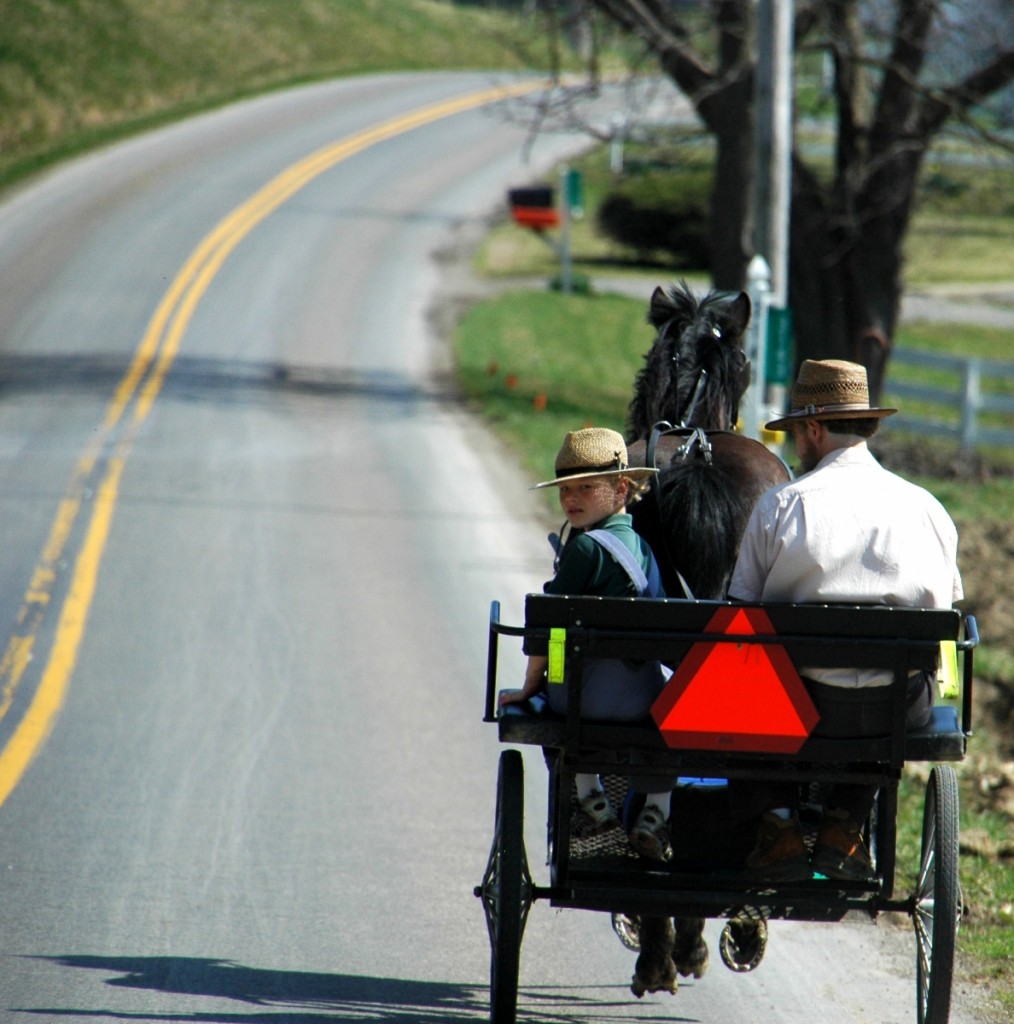
My senses begin to align, and I realize the clicking is actually the sound of horseshoes on pavement and Amish buggies outside. The smell of baked goods is the made-from-scratch blueberry pancakes cooked by Mennonite women in the kitchen of my bed-and-breakfast. It might be the most peaceful awakening I have ever experienced.
The Miller Haus Bed & Breakfast in Holmes County, Ohio, is my home base for exploring the back roads of Amish country. I will head out for the day along the winding rural roads where mile-markers are replaced by Yoder’s Cheese signs and laundry drying on the line. The miles will uncover a simpler life that still exists, hidden treasures unearthed if we take the time to look for them and non-tangible life nourishment that feeds the soul.
 Simpler Life
Simpler Life
Hidden throughout Indiana, Ohio, Pennsylvania, Delaware and New York, miles of tangled back roads lead to the country’s Amish communities. The families who live along these roads are untouched by the technological world that most of us cannot live without.
After leaving the Miller Haus for the morning, I drive onto County Road 135 in Millersburg, Ohio, to see where the day leads me. A montage of unfamiliar yet peaceful imagery blurs by me: horses grazing in the pasture; chickens pecking at feed on dirt driveways; Amish men and boys plowing the fields and Amish women picking fruit from the orchards. Driving with the top down on my convertible, I feel as if I’m a visitor to a P. Buckley Moss painting that has come to life.

An Amish buggy on the road slows me down to 20 mph. I start to feel anxious, forgetting that I have no reason to be. I have no agenda and no definitive destination. The buggy is a literal reminder I need to slow down in my life.
On these small county roads, the only stores I see are cheese factories and wood mills where everything is done by hand. Breakfast staples come from local markets where berries are picked fresh and eggs are collected each morning. Here, hard work still matters and there is a personal touch to all facets of life.
Hidden Treasures
When I slow down long enough to enjoy my surroundings, I start to notice the little treasures that make up the larger scene. It’s like looking at an impressionist painting: You see the image, but only when you get close enough to the art can you see and appreciate all of the little dots and colors that make it a masterpiece.
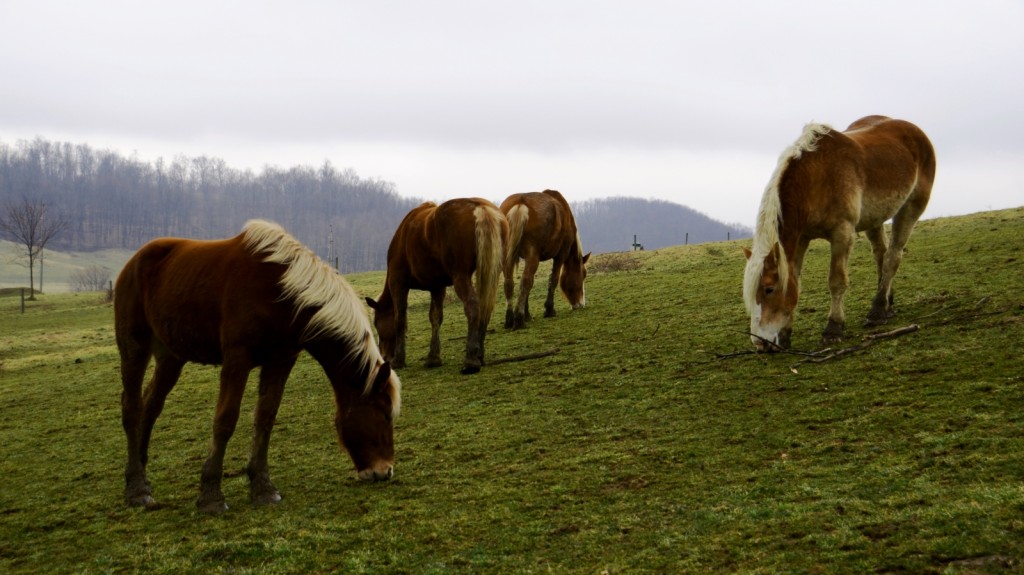
In Farmerstown, I make my way to County Road 114. I’m looking for “the blind broom maker” as the locals know him, and his small shop called Farmerstown Broom and Book. I knew it from a previous visit to the area when I met a very humble Amish woman and her legally blind husband who spent his days making brooms by hand in the shop at their home. They told me about the hours it takes to make the many sizes of brooms and their passion for creating durable high-quality products one at a time.
I remembered a small garage-turned-store where the only available light came from one tiny window. In one corner were completed brooms, hand-controlled equipment and piles of straw. Another area housed metal bookracks with children’s books on manners, cookbooks, spiritual books and religious daily devotionals. Natural ointments for burns and oils used for sleep aids were by the door.
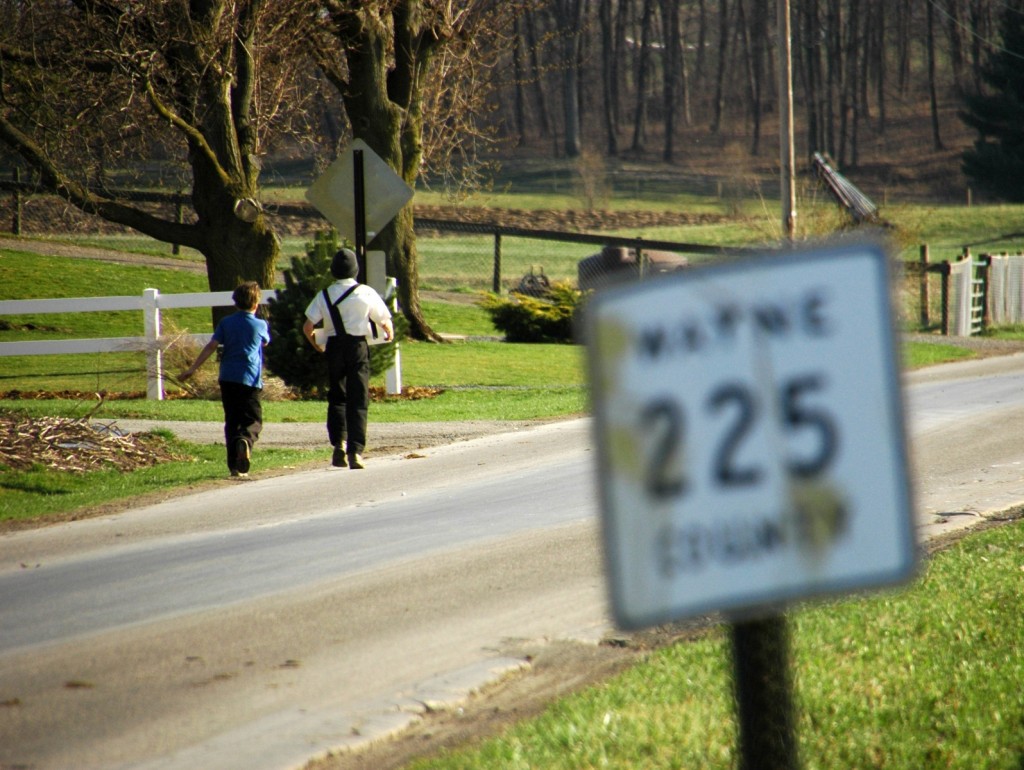
In the last corner of the room a frail woman sat wearing a plain dress held together by safety pins. I remember buying my broom and bee sting salve and getting on my way.
That brief visit with the blind broom maker and his wife made an impression on me. I wanted to find them again.
When I found the shop, everything looked exactly the same, down to the frail Amish woman sitting in front of a metal cash box. But one thing had changed: A few months earlier, the blind broom maker had died from cancer.
The few brooms in the corner were all that his wife had left of his handiwork to sell. The broom I purchased previously suddenly became a sentimental token of a shared moment I will never forget.
The true treasures of the back roads of Amish country are places like this that are found by mere chance or by word of mouth from the locals. The owner of my bed and breakfast, Lee Ann Miller, told me about another place called Yoder’s Bargain Store in Fredericksburg, Ohio. It is a shop used by locals and run by an Amish family.
The small gray stone at the end of Yoder’s long, winding driveway features white hand-painted letters in an understated display welcoming guests, but not advertising for them.
I feel almost intrusive driving up the unpaved farm entrance to the store. A horse and buggy is tied to a post outside. I park my convertible next to it, feeling the awkward juxtaposition of the two modes of transportation.
The dark, two-story shop is illuminated by a small amount of outside light, although some oil lamps are affixed to pillars. The room is silent. I quietly peruse tight aisles of glassware, trinkets, Amish work attire and cooking gadgets priced at a steal. My small basket was loaded with fruit dishes for less than $1, kitchen utensils and some very hearty wool hats and gloves.
The elderly Amish woman at the checkout added my items with a calculator. For less than $50 I had a stash of things that would’ve easily cost me $150 elsewhere. Conditioned for convenience, I almost presented my credit card before remembering that here, they sell and acquire goods the old fashioned way – with cash. Yoder’s Bargain Store was never designed to be a tourist stop, which is why so few know about it and why it is such a gem to find.
Self-discovery
The slower pace from point-A to point-B in Amish country is therapeutic. The reduced speedometer reading reminds me to notice things like the rolling countryside, windmills, hard labor in the fields and handmade baskets for sale on the side of the road. As I log miles on tight turns on seemingly endless county roads to nowhere, it all begins to equate for me.
I remember that living in the moment is something we choose. We make decisions about whether or not to notice flowering trees, a mother horse with her foal and the smell of fresh biscuits. There’s a sense of gratitude in the air, for family and relationships and things that are authentic.
To stop for a moment – for a day – for a weekend is to nourish the soul. A break in the churning of emails, appointments and deadlines is worthwhile, healthy and essential.
As darkness falls for the day, I draw the shades and rest my head while the country stars watch over me until morning. I can’t wait to see where tomorrow’s roads lead me.
All photos by Anietra Hamper. An award-winning writer based in the Midwest, Hamper is a frequent contributor to Positive365. Her previous features include a misty trip to Loch Ness, a journey of self-discovery in Southeast Asia, and a profile of a family whose home is bursting with love.
]]>